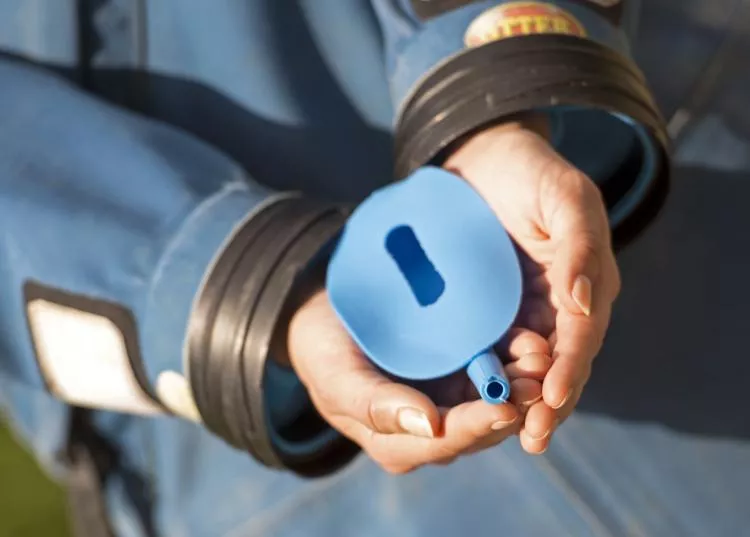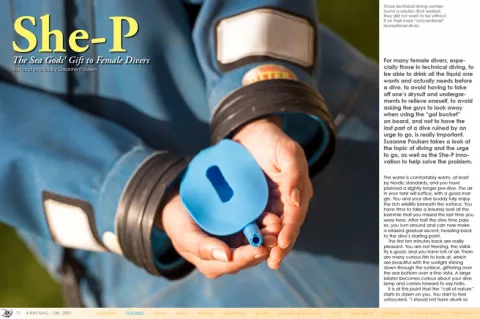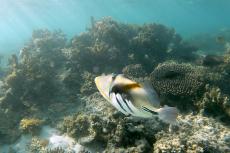For many female divers, especially those in technical diving, to be able to drink all the liquid one wants and actually needs before a dive, to avoid having to take off one’s drysuit and undergarments to relieve oneself, to avoid asking the guys to look away when using the “gal bucket” on board, and not to have the last part of a dive ruined by an urge to go, is really important. Susanne Paulsen takes a look at the topic of diving and the urge to go, as well as the She-P innovation to help solve the problem.
Contributed by
The water is comfortably warm, at least by Nordic standards, and you have planned a slightly longer pre-dive. The air in your tank will suffice, with a good margin. You and your dive buddy fully enjoy the rich wildlife beneath the surface. You have time to take a leisurely look at the bommie that you missed the last time you were here. After half the dive time passes, you turn around and can now make a relaxed gradual ascent, heading back to the dive’s starting point.
The first ten minutes back are really pleasant. You are not freezing, the visibility is good, and you have lots of air. There are many curious fish to look at, which are beautiful with the sunlight shining down through the surface, glittering over the sea bottom over a fine vista. A large lobster becomes curious about your dive lamp and comes forward to say hello.
It is at this point that the “call of nature” starts to dawn on you. You start to feel unfocused. “I should not have drunk so much coffee this morning,” you think yourself, and start paddling home a little faster. It is pressing hard now. “Must pee as soon as I get up.” Your thoughts have stopped revolving around the variety of wildlife before you, and the beautiful school of fish you pass feels quite uninteresting. The last 15 minutes of the dive mostly feel like an unnecessary pastime. Now, all you can think about is ascending, getting rid of your suit, and quickly easing the pressure. At the safety stop, the minutes seem go by as slowly as possible. Finally, you surface.
You leave the equipment at the shore and run up to the nearest helping hand for help with the zipper. You have a hard time standing still. Your dive friends happily ask, “How was it? How was the visibility? Did you see the nudibranchs at five meters, right by the bridge?” But you only have one goal in mind. You say a hopefully friendly, “Just a moment,” literally jump out of the suit and run the last bit, with the base halfway off, and finally— Aah...
NOW that you are relaxed, you can stroll back to your dive gang and be a little social, talk about the fantastic dive, take care of the equipment, and have a coffee. You bring out the water bottle. Half a liter may suffice. You do not want to face the same dilemma on the next dive…
Do you recognize yourself in this story? Good news, there is help available.
Background
Our male dive friends have long had the opportunity to “connect” with the wet elements of the environment via a pee valve (a condom catheter and urine dump valve). This made it possible for them to take longer dives, to practice technical diving, and to stay properly hydrated. As a male dive friend of mine said: “When I had to pee in my suit twice—once during the tech course and once on a wreck dive—I decided to get a pee valve.”
Historically, for female divers who wanted to get into technical diving, the only option for them had long been diapers. Both male and female divers use diapers, especially on advanced technical diving trips where “No. 2” must also be performed. But for most people, a diaper was not a good option. It was perhaps used more as a complement to the pee valve, so that (not to be indelicate here) there was no mixing of bodily excretions.
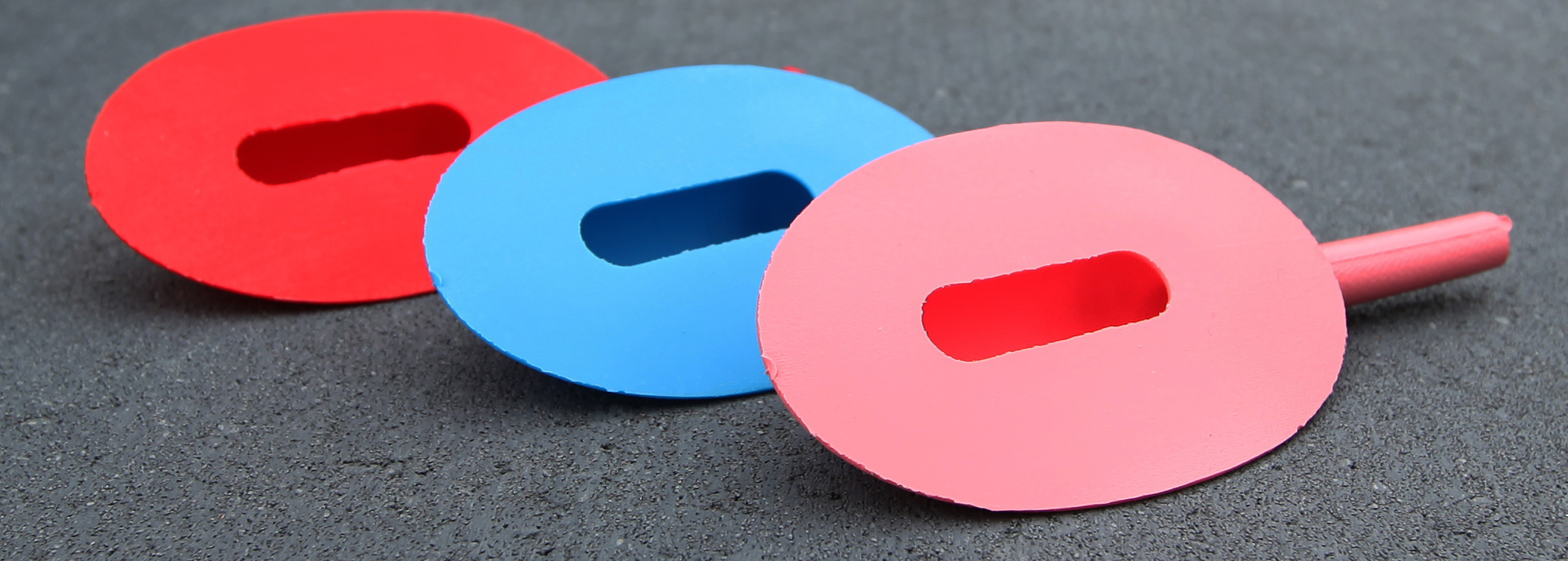
Enter the She-P
The She-P was developed in the Netherlands by Heleen Graauw, a female diver, dedicated to technical diving, who, during long deco stops, experienced great urges to relieve herself and needed a better solution. Since 2003, she has developed the She-P in several stages, from an experimentally hard and uncomfortable tube with a “backup diaper” to today’s flexible silicone cup with quick coupling.
The doors suddenly opened wide for women who wanted to practice technical diving—but also recreational diving. Once the tech women got a solution that worked, they did not want to be without it on their more “conventional” dives either. We are now talking about fairly common dives such as a weekend trip with the local dive club, with many repeated dives, or on a boat trip where one is happy to keep the suit on between dives and there may not even be a toilet on board. Or if it is a bit cold or rainy on land and you want to avoid taking off both your suit and your “one-piece” undergarment and sit half-naked on a cold outdoor toilet, or behind a bush, just to be able to do your business. Suddenly, the pieces of the puzzle fell into place.
So, how do other women solve this problem then? There are still only a few who actually use the She-P. Most of the women I talked to kept their fluid intake down during the day for the above practical reasons. They “solved the problem” by drinking less fluid between dives, holding on until they turned blue in the face, and/or made shorter dives—not because they wanted to, but because it would have been unbearable otherwise. They more or less accepted the fact that 25 percent of the dive would become painful.
Some divers plan their fluid intake by drinking a lot of fluid all at once and then waiting until it all has passed, before going diving. Then, they drink again after the dive to compensate. But regardless of whether you try to plan your fluid intake or not, you will need to relieve yourself. Why is this?
Planning your fluid intake can work quite well; but above all else, it is the time in the water that is the culprit in this drama. When a body is immersed in water, it is affected by the effects of immersion.
Diving and the urge to go
You will need to pee. Sometimes sooner, sometimes later. For the most part, far too early. You must compensate both for the fluid the body “accidentally” got rid of, in its belief that it has had too much fluid, and as fluid compensation for the dry air you breathe from your tank. Then there is the “normal” liquid consumption, which of course depends on the temperature on land, etc.
For me, diving is a relaxing activity, a kind of meditation that makes me be in the “here and now,” letting go of everyday life and just floating weightlessly in another world. For us recreational divers, this is how diving should be—a pleasure. You, therefore, want to try to avoid all the reasons why the dive might become difficult or stressful at some point. Will there be enough air? How is my dive buddy? Will I freeze? How is the visibility? Does the equipment work?
Some things can be influenced, others cannot. The amount of air can be adjusted. You can make sure that you have more than enough air, and possibly deco gas, for the planned dive—and a little bit more. With several different efforts, the cold can be set at an acceptable level, both by choosing the right equipment and by letting the water temperature control the dive time.
By using the She-P, I have now removed yet another obstacle to a comfortable and safe dive. My dive time varies between 30 and 120 minutes, depending on the conditions at the dive site and the day’s plan for me and my dive buddy. Nothing else. I can drink water whenever I want and how much I want, and I do not have to worry about the dive being ruined for reasons I can now control. For me, the She-P has taken diving to new levels.
What others say
Several of my female dive buddies use the She-P, and they all say the same thing. They use it in their usual recreational dives and experience the feeling of freedom as the biggest positive effect. To be able to drink all the liquid you want and actually need, to avoid taking off your suit and undergarments, to avoid asking the guys to look away when using the “gal bucket” on the boat, and not to have the last part of the dive ruined by a pressing urge, is really something that has great importance to all these women.
You will know who they are when you see their relaxed facial expressions during and after the dive. If you are in any way unsure, look for the small extra valve they have on the leg. These are the women you should ask, if you are interested in knowing more from someone who has tried it. You can buy the She-P at your local dive centre. If they do not have it in stock, ask them to order it for you, or order it directly from the maker’s online shop at she-p.com.
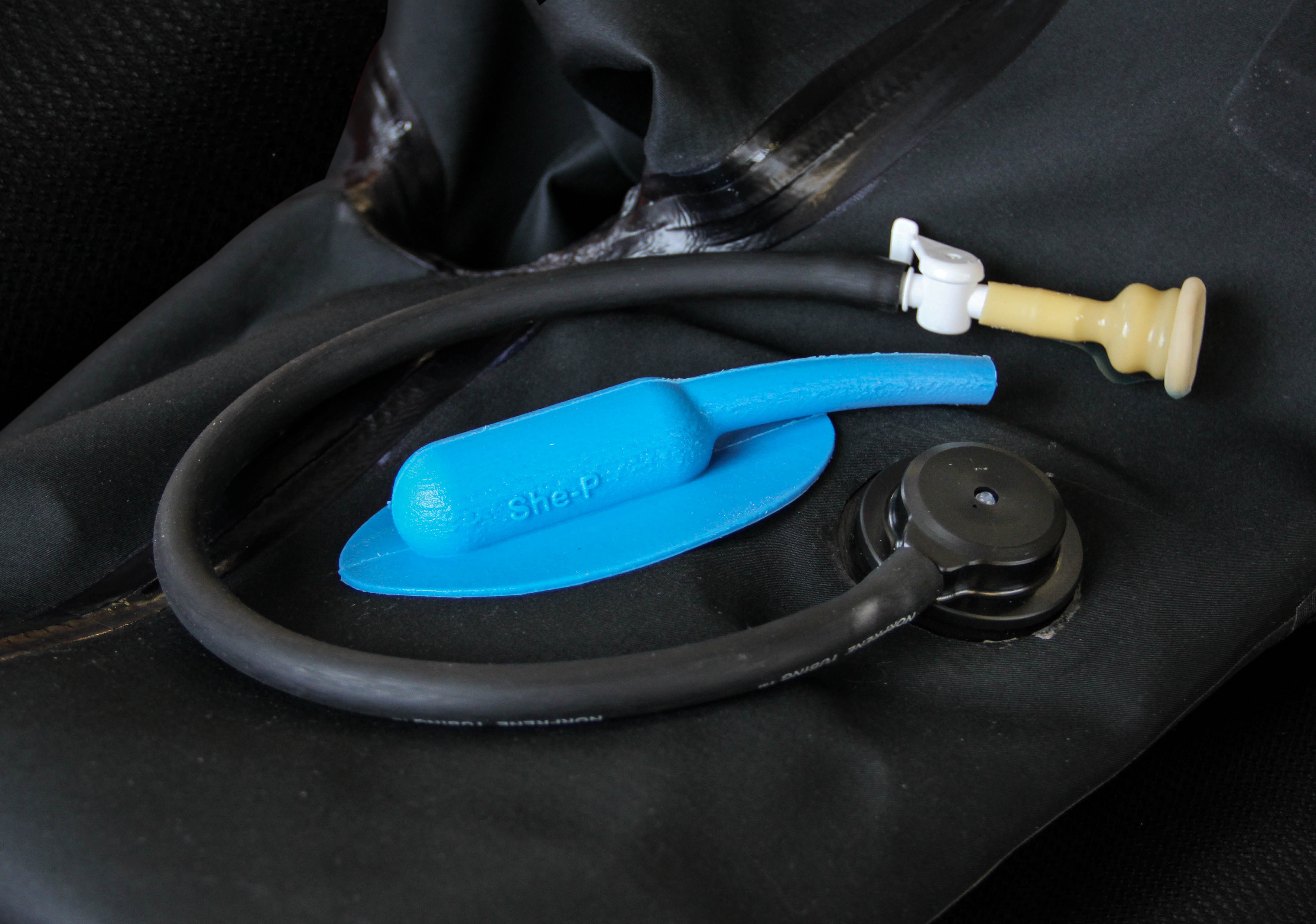
How does it work?
Many are interested, but few dare to ask. The She-P is a soft medical-grade silicone cup that is attached to the skin with the help of medical glue. It takes some practice to learn how to attach it securely, and you have to be extremely careful. The first few times, you should simply try to do it at home until you get it right, by touch. Once you have learned it, you can affix it quickly and easily before a dive. Then, the She-P works with all balanced pee valves in the same way as for men. After use, it is easily detached from the skin and cleaned with a special wet wipe, adapted for the purpose.
The team of women who developed the She-P have put a lot of effort into designing an instructional video, which is available on the website at: she-p.com. (Be careful with the spelling of the url—otherwise, you can end up on the wrong sort of webpages…). If you are thinking of becoming a new user, watch the video! It is very clear and pedagogically structured. There is also a closed group on Facebook called “The Divine Secret of the She-P Sisterhood,” in which users all over the world can ask questions and share their experiences.
Is the She-P for everyone? Absolutely not. As long as you do not feel that you have a problem, you do not need to fix it. Dive and enjoy! But if the urge to go bothers you or limits your diving, thank the gods, it’s there… ■
Susanne Paulsen is a technical diver, underwater photographer and dive writer based in Sweden. With her husband, Glen, she runs Team Paulsen AB, a dive and Poseidon rebreather centre in Gullmarn. For more information, visit: teampaulsen.se

